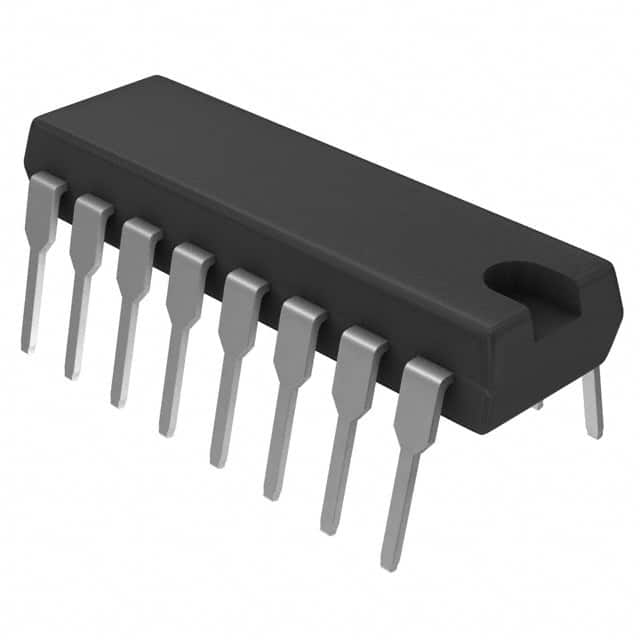Siehe Spezifikationen für Produktdetails.

MM74C221N
Product Overview
- Category: Integrated Circuit
- Use: Digital Logic Gates
- Characteristics: Dual Monostable Multivibrator
- Package: DIP (Dual In-line Package)
- Essence: The MM74C221N is a dual monostable multivibrator integrated circuit that can be used to generate precise time delays or pulses.
- Packaging/Quantity: Available in tubes of 25 units.
Specifications
- Supply Voltage: 5V
- Operating Temperature Range: -55°C to +125°C
- Propagation Delay Time: 35 ns
- Trigger Pulse Width: 30 ns
- Output Pulse Width: Adjustable from 30 ns to 2.4 seconds
- Trigger Input Voltage: 0.8V (min) to 2.0V (max)
- Output Current: 6 mA (max)
Pin Configuration
The MM74C221N has a total of 16 pins, which are assigned as follows:
- CLR1 - Clear Input for Timer 1
- TRIG1 - Trigger Input for Timer 1
- THR1 - Threshold Input for Timer 1
- DIS1 - Disable Input for Timer 1
- GND - Ground
- OUT1 - Output for Timer 1
- VCC - Positive Power Supply
- THR2 - Threshold Input for Timer 2
- TRIG2 - Trigger Input for Timer 2
- CLR2 - Clear Input for Timer 2
- DIS2 - Disable Input for Timer 2
- OUT2 - Output for Timer 2
- REXT - External Resistor Connection
- CEXT - External Capacitor Connection
- NC - No Connection
- NC - No Connection
Functional Features
- Dual monostable multivibrator with independent timers
- Precise time delay generation
- Adjustable output pulse width
- Trigger inputs for each timer
- Clear and disable inputs for each timer
- External resistor and capacitor connections for timing control
Advantages and Disadvantages
Advantages
- Dual timer functionality allows for versatile applications
- Precise and adjustable time delay generation
- Easy to use and integrate into digital logic circuits
- Wide operating temperature range (-55°C to +125°C)
- Low propagation delay time (35 ns)
Disadvantages
- Limited output current capacity (6 mA max)
- Requires external resistors and capacitors for timing control
Working Principles
The MM74C221N operates as a dual monostable multivibrator, which means it can generate a single output pulse of a precise duration when triggered. Each timer within the IC can be independently triggered and generates an output pulse whose width is determined by the external resistor and capacitor connected to the respective timing pins.
When a trigger input signal is applied to the corresponding trigger pin, the output of the timer goes high for a duration determined by the values of the external resistor and capacitor. The output remains high until the time period defined by the RC network elapses, after which it returns to its low state.
The clear and disable inputs provide additional control over the timers. The clear input resets the timers, forcing the output to go low immediately. The disable input, when activated, prevents the timers from being triggered.
Detailed Application Field Plans
The MM74C221N finds applications in various fields where precise time delays or pulses are required. Some potential application areas include:
- Timing circuits in digital systems
- Pulse shaping and waveform generation
- Delayed triggering of other devices
- Sequential logic circuitry
- Precision timing in communication systems
- Industrial automation and control systems
Alternative Models
- CD74HC221E
- SN74LS221N
- MC14528BCL
These alternative models offer similar functionality to the MM74C221N and can be used as replacements depending on specific requirements.
In conclusion, the MM74C221N is a dual monostable multivibrator integrated circuit that provides precise time delay generation. With its versatile features and wide range of applications, it offers an effective solution for various digital logic and timing requirements.
Listen Sie 10 häufige Fragen und Antworten im Zusammenhang mit der Anwendung von MM74C221N in technischen Lösungen auf
Sure! Here are 10 common questions and answers related to the application of MM74C221N in technical solutions:
Q: What is MM74C221N? A: MM74C221N is a dual monostable multivibrator IC, commonly used for timing and delay applications.
Q: What is the operating voltage range of MM74C221N? A: The operating voltage range of MM74C221N is typically between 3V and 18V.
Q: How does MM74C221N work? A: MM74C221N works by triggering the output pulse based on the input signal and the timing components connected to it.
Q: What is the maximum output pulse width that can be achieved with MM74C221N? A: The maximum output pulse width that can be achieved with MM74C221N is determined by the external timing components and can be up to several seconds.
Q: Can MM74C221N be used as a frequency divider? A: No, MM74C221N is not designed to function as a frequency divider. It is primarily used for generating precise time delays.
Q: What is the typical power consumption of MM74C221N? A: The typical power consumption of MM74C221N is relatively low, usually in the range of a few milliwatts.
Q: Can MM74C221N operate in both astable and monostable modes? A: No, MM74C221N is specifically designed for monostable operation. For astable operation, you would need a different type of multivibrator IC.
Q: Can MM74C221N be used in high-frequency applications? A: MM74C221N is not suitable for high-frequency applications as it has limited bandwidth and is more commonly used in low to moderate frequency ranges.
Q: What are the typical applications of MM74C221N? A: MM74C221N is commonly used in applications such as time delay circuits, pulse shaping, precision timing, and control systems.
Q: Are there any specific precautions to consider when using MM74C221N? A: It is important to ensure that the power supply voltage does not exceed the specified maximum limit (typically 18V) to prevent damage to the IC. Additionally, proper decoupling capacitors should be used to minimize noise and stabilize the power supply.

